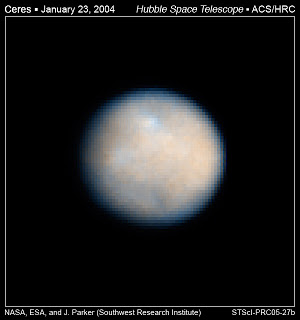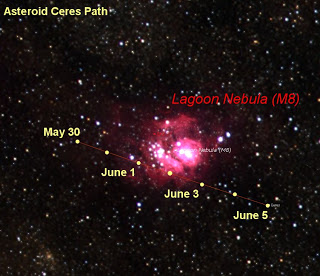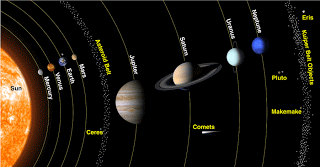Astronomy


Ceres is the only dwarf planet not found in the freezing cold, faraway Kuiper Belt. Rather, it orbits in the main asteroid belt between Mars and Jupiter, completing one lap around the sun every 4.6 years and its rotation period is 9.075 hours.Ceres is by far the largest object in the asteroid belt, containing about one-third of the belt's mass. However, at 590 miles (950 km) across, it is the smallest known dwarf planet. It is named after the Roman goddess of the harvest and motherly love.Because it's so much closer to Earth than the other dwarf planets, Ceres was discovered far earlier. Italian astronomer Giuseppe Piazzi spotted it first, on Jan. 1, 1801. For the next half-century, many astronomers regarded Ceres as a true planet.
Because Ceres is spherical, it is unlike the majority of the members of the asteroid belt. Its composition is also slightly different than its neighbors in the belt. Its surface is probably covered with a mixture of water ice, carbonates, and clays. This leads astronomers to believe that it formed differently from the other bodies in the asteroid belt. It is now believed that Ceres formed 4.6 billion years ago when the solar system was forming. Apparently, Ceres never accumulated enough matter to get larger than the 950 kilometers in diameter that it currently is. Ceres contains one-third of the mass found in the asteroid belt.Scientists believe that Ceres has a rocky core and an icy mantle. Some scientists also believe that it has a liquid water layer in its interior. This possibility makes Ceres very intriguing to scientists that are searching for signs of extraterrestrial life


Ceres has a very primitive surface and like a young planet, contains water-bearing minerals, and possibly a very weak atmosphere and frost. Infrared observations show that the surface is warm with a possible maximum temperature of 235 K (-38°C). Ceres ranges in its visual brightness magnitude from +6.9 to +9.. At its brightest point it is just barely too dim to be seen with the naked eye.

Ceres follows an orbit between Mars and Jupiter, within the asteroid belt, with a period of 4.6 Earth years The orbit is moderately inclined (i = 10.6° compared to 7° for Mercury and 17° for Pluto) and moderately eccentric (e = 0.08 compared to 0.09 for Mars).
Scientists and the world will get a much better look at Ceres less than four years from now. In February 2015, NASA's Dawn spacecraft ? which is currently orbiting Vesta, the asteroid belt's second-largest resident ? will arrive at Ceres to undertake a detailed study of the dwarf planet.

- Sky Watching Dec 18 - 25
Sky Watching 2012,December,18-25 Tue., December 18, 4 a.m. Ceres at opposition...
- Sky Watching December 9-11
Sky Watching 2012,December 9-11 Sun., December 9, 3 a.m Vesta at opposition : ...
- Do You Know - 3
Do You Know? - 3 1 . What is the name of the 2nd biggest planet in our solar system? Ans: Saturn ...
- Picture Of The Day Oct - 25
Picture Of The Day October 25 , Thursday The Cone Nebula (NGC 2264) ...
- Picture Of The Day
Picture Of The Day October 17, Wednesday ...
Astronomy
Ceres
Ceres

Mass : 895.8E18 kg
Orbital period : 1,680 days
Density : 2.08 g/cm³
Gravity : 0.27 m/s²
Discovered : January 1, 1801
Discovered by : Giuseppe Piazzi

Because Ceres is spherical, it is unlike the majority of the members of the asteroid belt. Its composition is also slightly different than its neighbors in the belt. Its surface is probably covered with a mixture of water ice, carbonates, and clays. This leads astronomers to believe that it formed differently from the other bodies in the asteroid belt. It is now believed that Ceres formed 4.6 billion years ago when the solar system was forming. Apparently, Ceres never accumulated enough matter to get larger than the 950 kilometers in diameter that it currently is. Ceres contains one-third of the mass found in the asteroid belt.Scientists believe that Ceres has a rocky core and an icy mantle. Some scientists also believe that it has a liquid water layer in its interior. This possibility makes Ceres very intriguing to scientists that are searching for signs of extraterrestrial life



(Dawn: Vesta Departure & Ceres Arrival Animation [720p])

- Sky Watching Dec 18 - 25
Sky Watching 2012,December,18-25 Tue., December 18, 4 a.m. Ceres at opposition...
- Sky Watching December 9-11
Sky Watching 2012,December 9-11 Sun., December 9, 3 a.m Vesta at opposition : ...
- Do You Know - 3
Do You Know? - 3 1 . What is the name of the 2nd biggest planet in our solar system? Ans: Saturn ...
- Picture Of The Day Oct - 25
Picture Of The Day October 25 , Thursday The Cone Nebula (NGC 2264) ...
- Picture Of The Day
Picture Of The Day October 17, Wednesday ...
